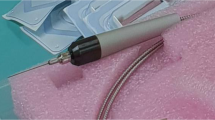Abstract
To investigate whether ocular hypotony formation with 360 degrees endocyclophotocoagulation is possible. Twelve male New Zealand White rabbits were used. Entire ciliary body epithelium was destructed with green laser photocoagulation after pars plana lensectomy and anterior vitrectomy in six rabbits. Endocyclophotocoagulation was not performed to the remaining six rabbits (control group). Intraocular pressure (IOP) was measured preoperatively and followed up everyday in the first week and weekly until the end of month one. All of the rabbits were sacrificed and ciliary bodies were left for gross and light microscopic examination. Mean baseline IOPs were similar in laser and non-laser group (14.8 ± 1.4 (range 12.2–17.3) vs 14.4 ± 1.4 (range 12.2–15.9), p = 0.650). Mean IOP was 6.6 ± 0.45 mmHg (range 5.9–7.1) in the laser group and 11.5 ± 1.2 mmHg (range 10.2–13.4) in the non-laser group in postoperative day 1. IOP was below 4 mmHg in all eyes on the second day and after in laser group. In the macroscopic evaluation, the entire ciliary body had a white (loss of pigmentation) and atrophic appearance in all of the eyes in the laser-treated group compared to non-laser group. In the laser group, light microscopic examination demonstrated a severe 360 degrees disruption of ciliary processes. Ciliary processes were covered with fibrin exudation consisting of fibroblasts. There was a mild inflammation with disruption or atrophy of ciliary body epithelium with cystic vacuolar degeneration. Three hundred sixty degrees endocyclophotocoagulation yielded severe ciliary epithelium damage. IOP reduction started very early and continued in hypotonic levels during follow up period.




Similar content being viewed by others
References
Costa VP, Arcieri ES (2007) Hypotony maculopathy. Acta Ophthalmol Scand 85:586–597
Streeten BW, Belkowitz M (1967) Experimental hypotony with silastic. Arch Ophthalmol 78(4):503–511
Pederson JE, MacLellan HM (1928) Medical therapy for experimental hypotony. Arch Ophthalmol 100:815–817
Kim HC, Hayashi A, Shalash A, de Juan E (1998) A model of chronic hypotony in the rabbit. Graefes Arch Clin Exp Ophthalmol 236:69–74
Dellaporta A, Obear MF (1964) Hyposecretion hypotony: experimental hypotony through detachment of the uvea. Am J Ophthalmol 58:785–789
Coleman DJ (1995) Evaluation of ciliary body detachment in hypotony. Retina 15:312–318
Zarbin MA, Michels RG, Green WR (1991) Dissection of epiciliary tissue to treat chronic hypotony after surgery for retinal detachment with proliferative vitreoretinopathy. Retina 11:208–213
Assia EI, Hennis HL, Stewart WC, Legler UF, Carlson AN, Apple DJ (1991) A comparison of neodymium: yttrium aluminum garnet and diode laser transscleral cyclophotocoagulation and cyclocryotherapy. Invest Ophthalmol Vis Sci 32:2774–2778
Iliev ME, Gerber S (2007) Long-term outcome of trans-scleral diode laser cyclophotocoagulation in refractory glaucoma. Br J Ophthalmol 91:1631–1635
Haller JA (1996) Transvitreal endocyclophotocoagulation. Trans Am Ophthalmol Soc 94:589–676
Kaplowitz K, Kuei A, Klenofsky B, Abazari A, Honkanen R (2015) The use of endoscopic cyclophotocoagulation for moderate to advanced glaucoma. Acta Ophthalmol 93:395–401
Lee PF (1979) Argon laser photocoagulation of the ciliary processes in cases of aphakic glaucoma. Arch Ophthalmol 97:2135–2138
Nadelstein B, Wilcock B, Cook C et al (1997) Clinical and histopathologic effect of diode laser transcleral cyclophotocoagulation in the normal canine eye. Veterinary Opthalmology 7:155–162
Shields MB (1986) Intraocular cyclophotocoagulation. Trans Ophthalmol Soc UK 105:237–241
Shields HB, Chandler DB, Hickingbotham D et al (1985) Intraocular cyclophotocoagulation: histopathologic evaluation in primates. Arch Ophthalmol 103:1731–1735
Küçükerdönmez C, Beutel J, Bartz-Schmidt KU, Gelisken F (2009) Treatment of chronic ocular hypotony with intraocular application of sodium hyaluronate. Br J Ophthalmol 93(2):235–239
Author information
Authors and Affiliations
Corresponding author
Ethics declarations
Conflict of interest
The authors declare that they have no conflict of interest.
Rights and permissions
About this article
Cite this article
Gurelik, G., Sul, S., Gocun, P.U. et al. Argon laser-assisted hypotony model in the rabbit. Lasers Med Sci 34, 11–14 (2019). https://doi.org/10.1007/s10103-018-2570-1
Received:
Accepted:
Published:
Issue Date:
DOI: https://doi.org/10.1007/s10103-018-2570-1




